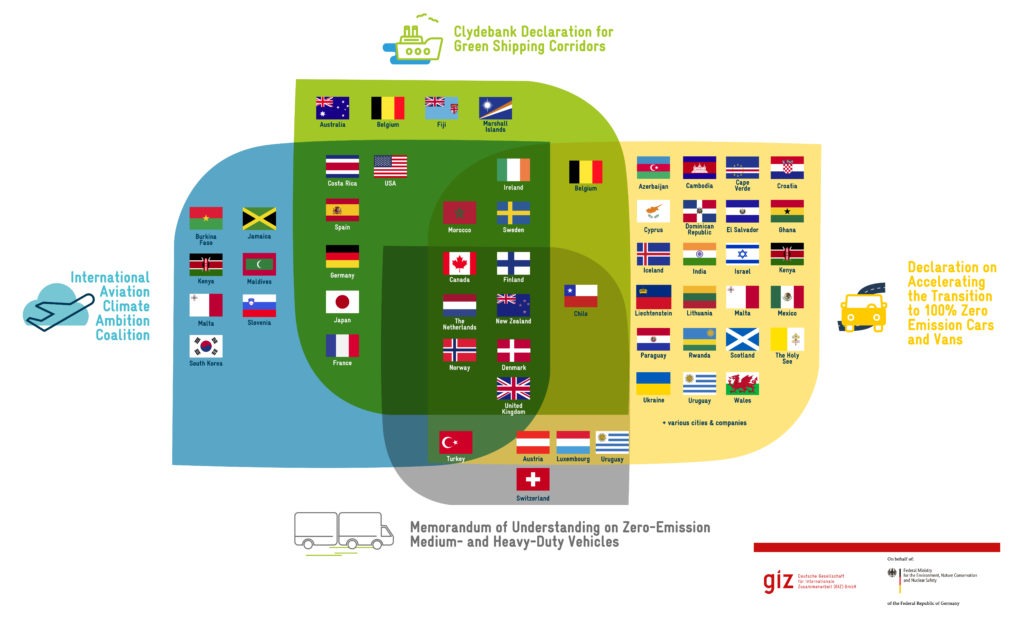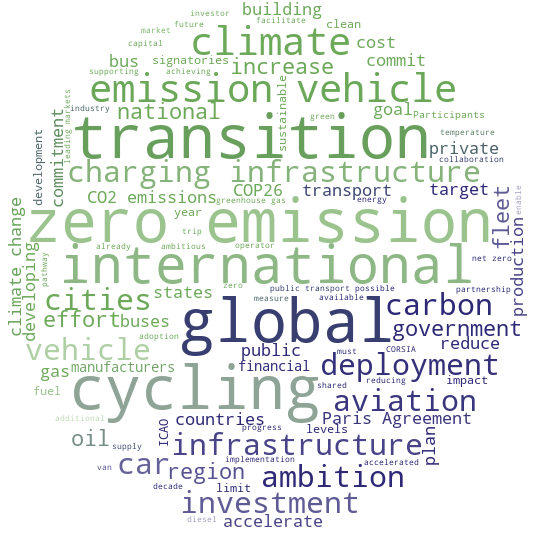7 December 2021 In Adaptation, Blog Post, Climate Change, Dialogue and Networking, Global, Mitigation, Morning Commute Blog, News, Report, Paper or Issue Brief, Sustainable Development
Transport commitments and initiatives launched at the UN Climate Change Conference (COP26)
COP26 saw an unprecedented number of commitments and initiatives on sustainable, low carbon transport. In this section we will take a closer look at some of them and provide a preliminary analysis of the degree of alignment between and the new NDCs submitted by countries which signed up to the initiatives.
- Overview and Assessment of Transport Commitments and Initiatives Launched at COP26
A record number of commitments and initiatives related to transport were launched on the occasion of the UN Climate Change Conference COP26; speaking of the increased attention to transport at COPs that has been gaining over the years. The following table outlines them, their scope, signatories and some open questions regarding their potential impact. For a full list of signatories, please refer to the links and consult the figures included in the following pages of this report.
| Initiative | Scope | Initiator(s) | Signatories (as of 22.11.2021) | Open Questions |
| COP26 World Leaders Summit – Breakthroughs Agenda | ||||
| Breakthrough Agenda – Road Transport | Establish zero emission vehicles as the new normal and accessible, affordable, and sustainable vehicles in all regions by 2030 | COP26 World Leaders Summit | 28 countries EU Five international institutions and initiatives The importance of the following global initiatives to making progress and coordinating activities is noted: Clean Energy Ministerial’s Electric Vehicle Initiative Climate Group’s EV100 and Route Zero First Movers Coalition Transport Decarbonisation Alliance Zero Emission Vehicle Transition Council | What kind of supplementary commitments – to ensure robust regulation and supporting infrastructure – will be required to ensure this push to zero emission vehicles is successful? Will this COP26 Breakthrough be strong enough a signal to boost the alignment of international and domestic transport finance with Paris Agreement targets? |
| UK COP26 Presidency | ||||
| International Aviation Climate Ambition Coalition | Support ambitious action on international aviation emissions, including a new global goal and promotion of cleaner fuels and technologies | UK COP26 Presidency | 24 countries | By relying on the International Civil Aviation Organisation’s (ICAO) offsetting scheme – considered as largely ineffective by many – and not calling for signatories to include aviation emissions in their national climate targets,will this Coalition put in motion transformative progress? |
| Clydebank Declaration for Green Shipping Corridors | Support the establishment of green shipping corridors – zero-emission maritime routes between 2 (or more) ports | UK COP26 Presidency | 22 countries | Will the declaration add pressure on the International Maritime Organization (IMO) to pursue more ambitious targets? Without a specific focus on the development and production of zero-emission powered vessels, will this declaration impact positively on real-economy actors and markets? |
| Declaration on Accelerating the Transition to 100% Zero Emission Cars and Vans | Work towards all sales of new cars and vans being zero emission globally by 2040, and by no later than 2035 in leading markets | UK COP26 Presidency | 38 countries 44 cities, states and regional governments 11 automotive manufacturers 27 fleet owners and operators or shared mobility platforms 13 investors with significant shareholdings in automotive manufacturers 2 financial institutions 19 other signatories | What will be the impact of the absence of the world’s three largest car markets – the United States of America, Germany and China; as well as France and Spain from the list of signatories? Is 2040 raising the ambition enough to reach the urgent goal of zero emissions by mid-century; particularly for countries which are enjoying enabling environments? Or is it a “minimum common denominator” approach? With remarks recognising the need to support holistic approaches to transport systems, including active travel, public transport and shared mobility, added last-minute following the strong mobilisation by stakeholders, as well as public statements by some Parties; will future COPs capitalise on this mobilisation, in order to enable systemic approaches to transport transformation across different geographies? |
| Transport community ecosystem | ||||
| COP26 Cycling Letter | Boost cycling levels to reduce carbon emissions and reach global climate goals quickly and effectively | European Cyclists’ Federation A global coalition of over 60 pro-cycling organisations | 350 organisations | In the ongoing context of heightened attention to transport electrification, will future COPs capitalise on this mobilisation in order to enable cycling’s central role to decarbonisation across different geographies? |
| Memorandum of Understanding on Zero- Emission Medium- and Heavy-Duty Vehicles | Enable 100% zero-emission new truck and bus sales by 2040 Interim goal of 30% zero-emission vehicle sales by 2030 To facilitate the achievement of net-zero carbon emissions by 2050 | CALSTART’s Global Commercial Vehicle Drive to Zero program and campaign The Netherlands | 15 countries | Since this global memorandum covers road transport modes not covered in UK COP26 Presidency-led declarations, could it encourage a broader declaration at COP27 on trucks and buses with more signatories across different geographies? How will this Memorandum link with the work of the UK COP26 Presidency-led Zero Emissions Transition Council? How will the signatory countries drive action by vehicle manufacturers and their customers? |
| Call to Action: Charge Forward to Zero Emissions Transportation | Accelerate electric vehicle charging infrastructure | Transport Decarbonisation Alliance | 37 signatories across countries; cities regions, states, and companies | Could the focus on electric vehicle charging infrastructure distract from required action on the challenge of facilitating electric vehicle uptake? Will this call to action succeed in breaking this so-called chicken-egg dynamic? |
| Invest more than a billion US dollars in zero-emission public bus fleets in Latin America | C40 Cities The International Council on Clean Transportation (ICCT) | 10 international investors | Can this initiative be replicated across other regions, especially where there is a general lack of public transport? | |
| Beyond Oil and Gas Alliance (BOGA) Declaration | Limit oil and gas production and extraction and plan for a just, equitable, and managed phase-out of existing oil and gas production | BOGA Alliance | 12 countries (either as core or associate members or friends of BOGA) | With none of the signatories being major oil and gas producers and no timeframe or specific target, will this declaration offer a reinforcing mechanism for the relevant aspects of the Glasgow Climate Pact? |
xc

Mapping by GIZ’s Advancing Transport Climate Strategies Programme (TraCS)
Source: Received from GIZ TraCS
Content of Transport Commitments and Initiatives Launched at COP26

Word cloud by SLOCAT Secretariat. Font size expresses the frequency of the words mentioned, color and position have no meaning.
Some key findings:
- New “zero emission road vehicles” received a large focus (mentions to bus, van, cars, vehicles and fleet(s), charging infrastructure though much lesser, still enhancing this focus).
- “Cycling” achieved a large focus: The lack of cycling, walking and public transport prominence in the COP26 presidency programme was heavily criticised by NGOs (Carlton Reid on Forbes). Remarks recognising the need to support holistic approaches to transport systems, including active travel, public transport and shared mobility were only added to the UK COP26 Presidency-initiated Declaration on Accelerating the Transition to 100% Zero Emission Cars and Vans, following strong mobilisation by stakeholders, as well as public statements by some Parties.
- “Transition” received a large focus, with prominence in the Declaration on Accelerating the Transition to 100% Zero Emission Cars and Vans made.
- “Global” and “international” got a large focus, reflecting the nature of a UN Climate Change Conference COP.
- “Aviation” and “ICAO” received some focus, reflecting the need to increase the ambition to mitigate the climate impacts by the aviation sector.
- The references to “national”, “government”, and “countries” reflect the major signatories of the declarations.
- The references to “cities” and “states” reflect the support some of the initiatives enjoyed from sub-national entities; as well as the recognition of the important leading role of these governmental stakeholders.
- The references to “manufacturers”, “companies” and “operators” (including related words, such as “market(s)”, “investor”, “private”, and “production”) reflect the acknowledgement of the need to engage private sector and industry stakeholders.